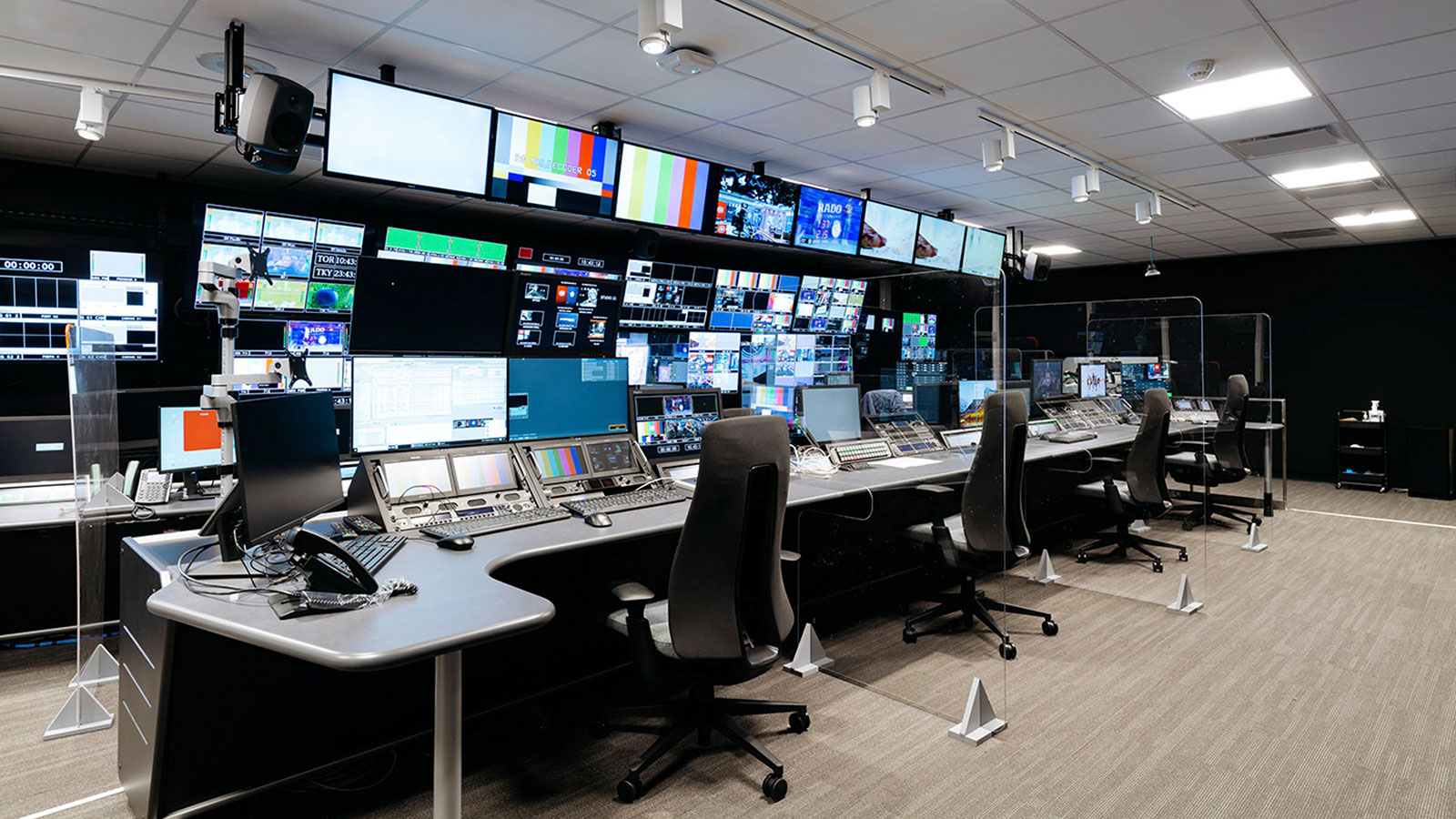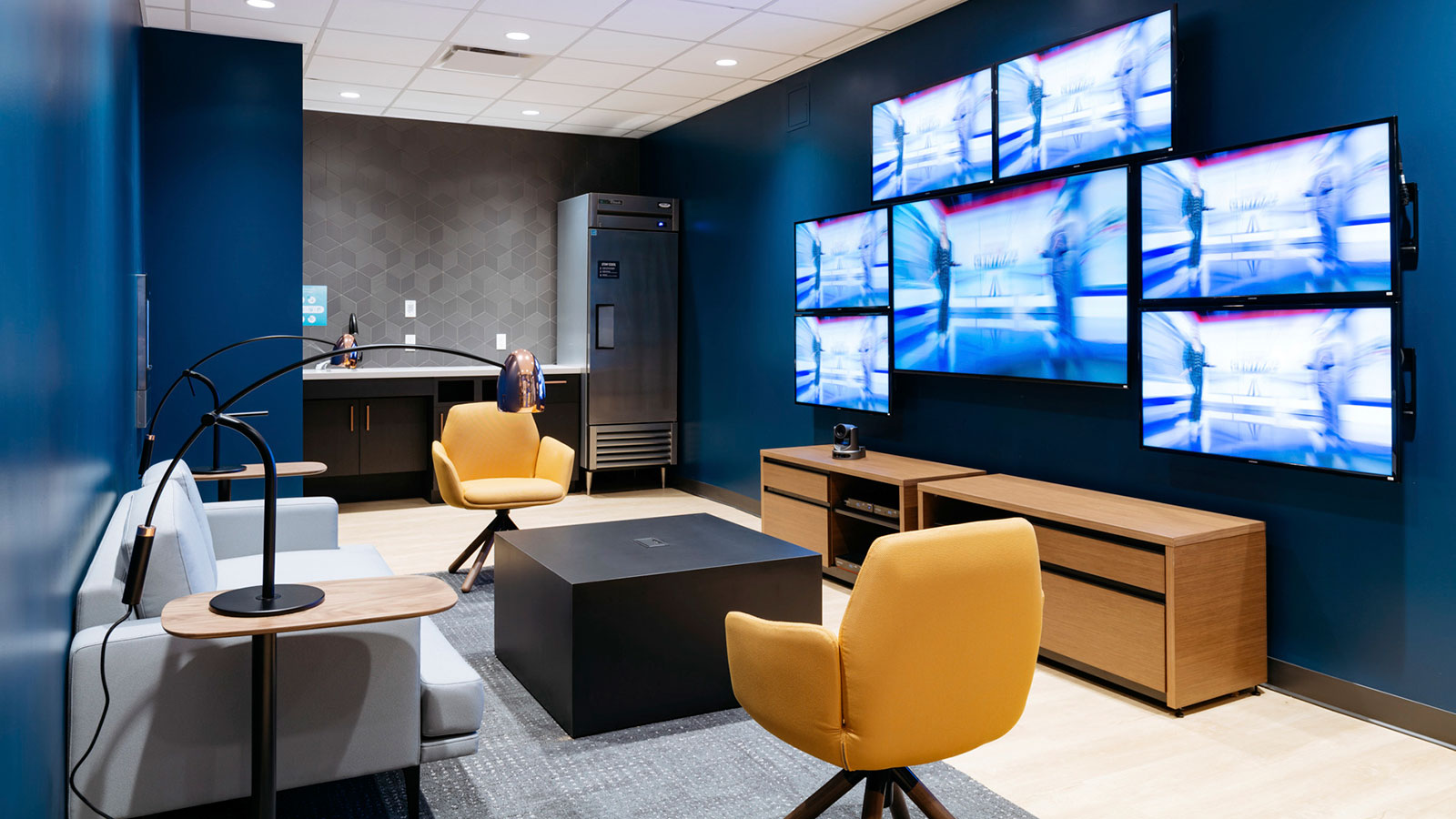#{Title}
#{Copy}
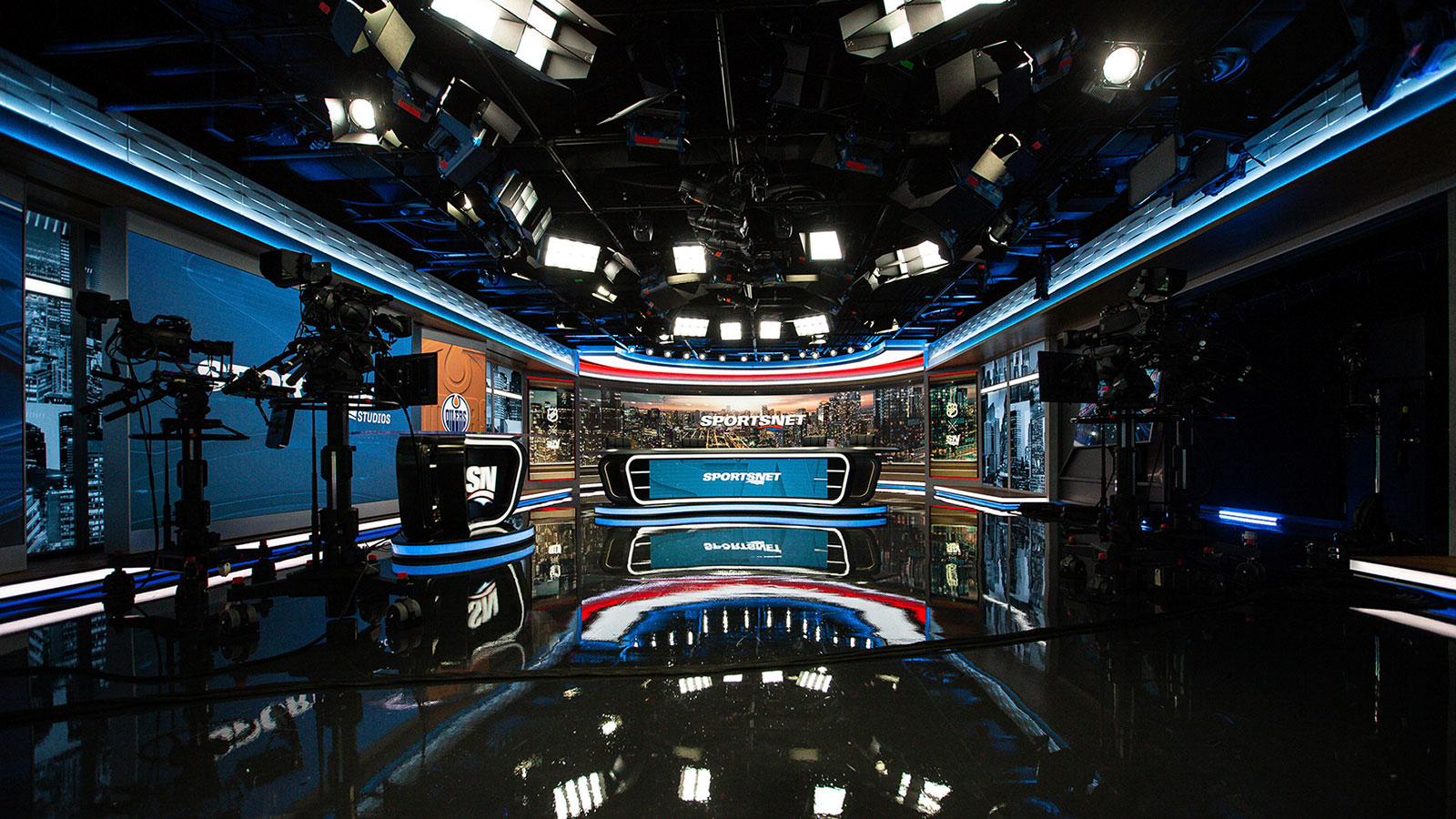
Rogers Sports & Media has created a new home for Sportsnet Studios, delivering an immersive sports experience that will enhance the network’s connection with its viewers whilst bringing the thrill of Hockey into people’s homes. Fans’ desire for regular sporting events, combined with more focus on streaming services, 5G, mobile technologies and the consolidation of media broadcasting have increased the pressures on broadcasters to deliver better content.
BDP’s media environments team collaborated with production engineers, set, lighting and acoustical experts to design and renovate spaces within two existing office buildings in downtown Toronto into an all-encompassing sports hub. Sportsnet Studios features new video, sound and movement capture technology, delivering a prototype for future broadcast studios.

The 16,600 square foot facility incorporates sustainability and WELL standard practices and comprises a reception, green rooms, hair and make-up areas, change and wardrobe rooms, meeting/viewing and phone rooms, control room suites, an array of broadcast support areas and two broadcast studios that connect to form a single, large studio area. An acoustic window in the lobby of the host building provides a view into the space, so the entire team within the Rogers headquarters can see what’s happening in the studio.
The historic building, where the majority of the development took place, was constructed as the former Confederation Life Insurance Company in 1956 with concrete encased steel structure and floor-to-floor heights intended for conventional office use. Care was taken to sensitively transform the existing buildings to create an innovative platform that enhances the working methodologies of the sportscasters and feed their creativity and expression. This all happened in a compressed timeline during the most challenging times of the pandemic, in a space that was not initially designed to be a studio.
The focus was given to collaborative working to find solutions to house the complex requirements of media environment in a unique interior space, and still maximize the overall studio’s accessibility, flexibility, openness and technological integration. There were numerous challenges faced during the project and a plethora of creative solutions were implemented during the design and build of this REmmy Award-winning broadcasting hub.


Adaption and optimization of the existing space
The main challenge was to fit a TV studio into an existing space that had never housed a broadcast studio before. Typical studio retrofits still have high ceilings, large open floor plates and are ideally removed from sources of significant noise and vibration. In the case of the Sportsnet Studios, none of these conditions needed to be created.
To accommodate the studios in the existing conventional office space, the design team worked closely with Sportsnet production engineers, set and lighting designers and industry experts to ensure a studio that provided a high level of production quality which maximized every millimeter of space available. Advancements in technology, set design, LED volumes and immersive environments all made the vision possible.
One of the biggest challenges to overcome was the limited ceiling height. The ceilings of the existing space needed to be reimagined to accommodate camera movements and angles and the rigging for lighting and sets. To accomplish this, all existing mechanical and electrical services in the ceiling space were decommissioned or relocated so we would be starting with a clean slate to optimize the available height. The existing access floor was also removed to gain extra headroom.
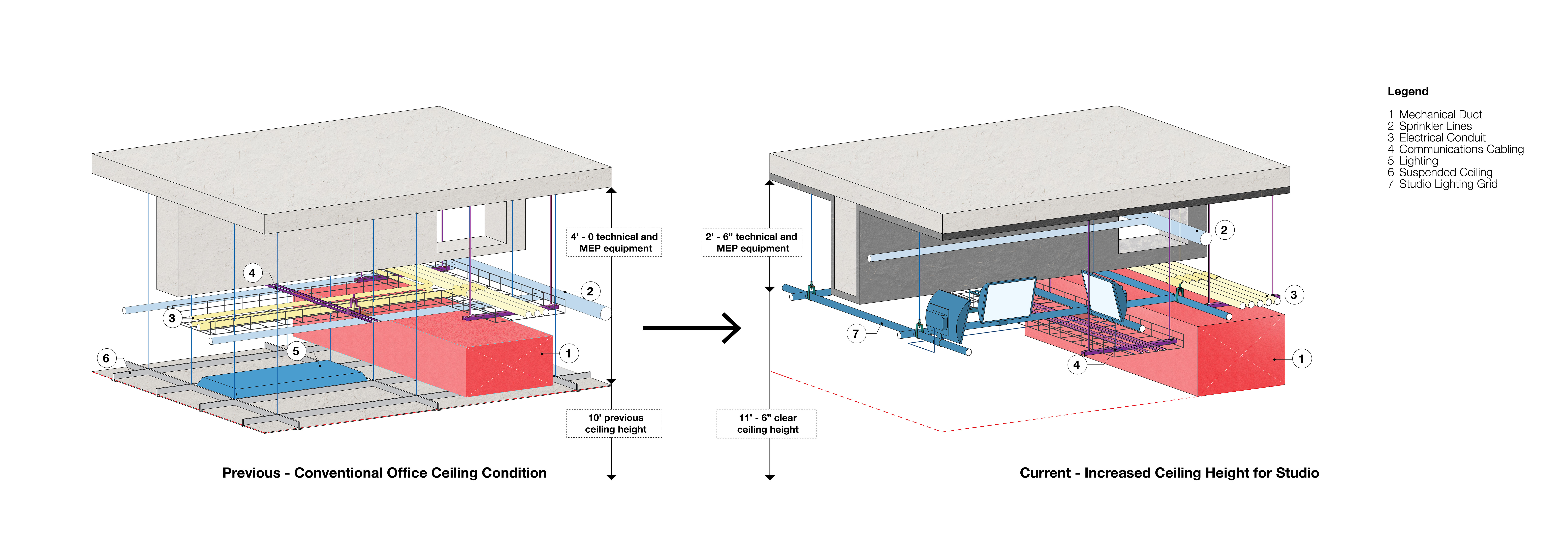
Next, BDP worked with the mechanical and electrical engineers to carefully locate all the servicing between the existing beams or around the perimeter of the rooms. The ceiling-hung lighting grid was reviewed with the set designers, production team, lighting designers and contractor to sit tight to the existing beams. The majority of the lighting and rigging, which would typically be mounted below the grid, were placed above it and between the beams to keep the studio ceiling height as high as possible.
Preserving the historic façade
The building façade is heritage listed by the City of Toronto, designed as a pressurized wall system behind the stone and brick cladding to maintain the thermal performance and integrity of the envelope. Because of this, the project team was unable to penetrate the existing exterior walls. As such, it had to come up with creative alternatives to common acoustic practices to mitigate the noise generated from the surrounding streets.
Without touching the exterior walls, an inner wall was constructed around the studios to block out daylight and noise from the busy urban street outside, and provide a surface to secure set walls, rigging and acoustic treatment. A mechanical system was installed between the walls to ventilate the cavity and prevent condensation on the existing windows. Specialty acoustic doors were provided at each window to allow for servicing and maintenance of the windows and to maintain the emergency smoke exhaust system in the building.
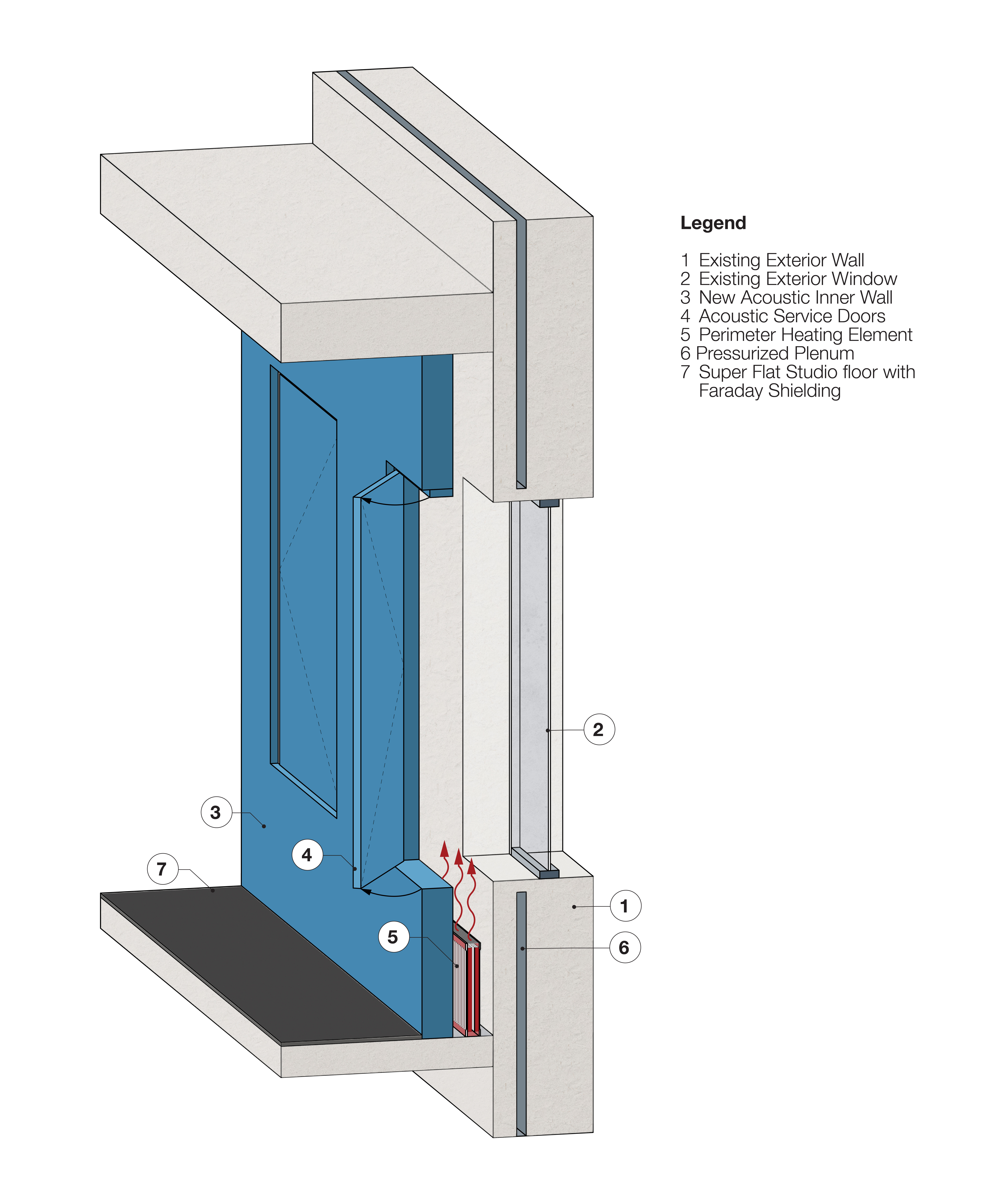
Tackling transformer vault interference
A large transformer vault serving the Rogers campus is located directly below the studio space. Electromagnetic frequencies emitted from this equipment can interfere with the technology and sensitive equipment used in the studios.
Questioning the frequencies emitted from the transformer vault, an electromagnetic shielding consultant was engaged to test the levels of electromagnetic infiltration into the studio space. Tests showed that protection was required, so faraday shielding was installed on top of the concrete floor slab.
Diligent and extensive coordination with the contractor, shielding installer, flooring installer and floor sealant manufacture, provided a solution to cover the faraday shielding with self-leveling concrete to give the studios a very flat epoxy floor finish required for camera operation, with negligible reduction to the studios ceiling height.
Incorporating the latest technology
To achieve the network’s vision for an innovative, interactive and immersive viewer experience, we collaborated with set and production designers, and project team to provide all the infrastructure that would support a state-of-the-art broadcasting.
The studios feature a green screen as well as an LED volume and several movable LED walls to integrate virtual sets, augmented reality and an immersive environment to create one of the first large-scale, entirely IP-based sports studios in North America. All this is linked together with 50,000 ft of video cables, 75,000 ft of network cables and 55,000 ft of audio cables.
Intensive coordination with the mechanical and electrical engineers, systems integrators, and the lighting and set designers to install the AV/broadcast infrastructure ensured the specified camera angles, positions and clearances were achieved. An alternative approach to mounting the screens was adopted by fixing them to the floor. Due to the limited load capacities in the slab above. The team studied the scans of the slab to locate existing trenches, conduit and other obstructions hidden within the concrete. That information was used to modify the framing and supports, avoiding these obstructions to securely anchor the LED volume.
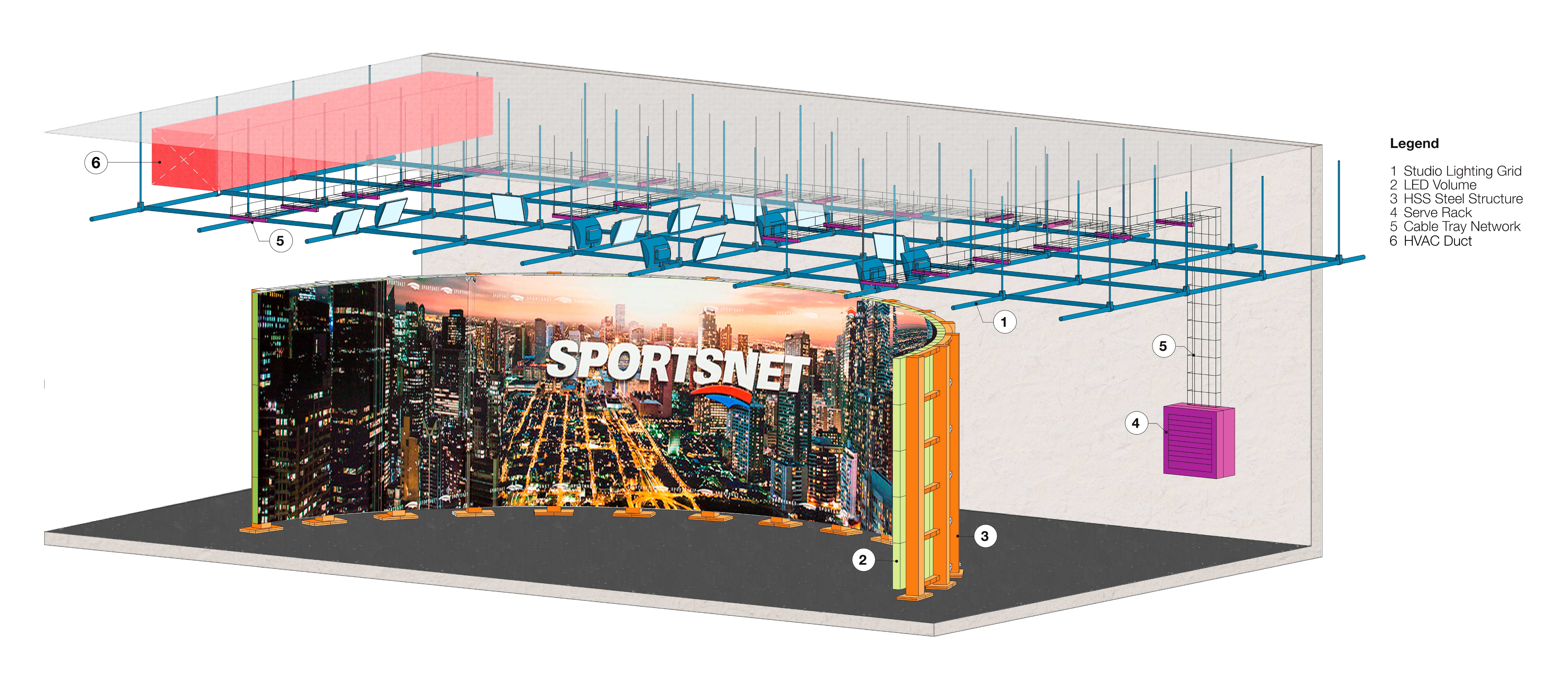
This is the first Rogers Sports & Media studio to deliver content in a virtual and augmented reality studio, via streaming services over its 5G network. It utilizes advanced mobile technologies, and works to consolidate multi-media broadcasting. This allows viewers to stream programs on any type of device and platform, or indeed on multiple devices and platforms at once.
In addition to providing unique storytelling for Canadian viewers, Sportsnet Studios’ extensive displays open up countless opportunities for the network’s partners and advertisers to activate in-broadcast and collaborate with Sportsnet’s content creators.
“With the construction of the Sportsnet Studios, we have built the foundation of the network’s reimagined approach to the traditional hockey broadcast, content production and distribution,” said Jason Harding, VP Creative, Rogers Sports & Media. “The state-of-the-art technology, data capabilities and increased in-broadcast versatility allows the Sportsnet team to push the envelope and create interactive, immersive and innovative content. We truly thank all the consultants involved in bringing our vision of Sportsnet Studios into reality.”
